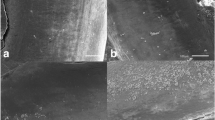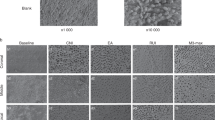Abstract
Objectives
The aim of this study was to evaluate the efficacy of two passive ultrasonic irrigation (PUI) methods and conventional manual irrigation (CMI) in root canal system (RCS) cleaning.
Materials and methods
Artificial single-rooted teeth were used. Four lateral canals were made 2 and 7 mm short from the apex. Root canals were filled with a contrast solution. The specimens were divided into four groups (n = 8): PUI1—intermittent flushing; PUI2—continuous flushing; CMI1—at 1 mm; and CMI2—at 3 mm. Micro-computed tomographic images were obtained. New images were taken after the irrigation protocols enabling the evaluation of the contrast solution volume (in mm3) within RCS (main and lateral root canals) in comparison to the initial analysis. The comparison among groups was performed using ANOVA and Tukey’s tests with 5 % significance level.
Results
There was no difference among PUI1, PUI2, and CMI1 regarding the contrast solution removal from RCS (p > 0.05). These methods demonstrated greater cleaning than CMI2. At the apical third, CMI2 showed lower cleaning capacity when compared to the other methods (p < 0.05).
Conclusions
PUI with intermittent or continuous flushing and CMI with the needle placed 1 mm from the working length were efficient in cleaning the main and lateral root canals.
Clinical relevance
Root canal irrigation plays an important role in cleaning and disinfection of the RCS. Effective apical irrigation is an important procedure during root canal treatment. PUI and CMI (at 1 mm short) were effective in cleaning of the main and simulated lateral root canals.



Similar content being viewed by others
References
Beus C, Safavi K, Stratton J, Kaufman B (2012) Comparison of the effect of two endodontic irrigation protocols on the elimination of bacteria from root canal system: a prospective, randomized clinical trial. J Endod 38:1479–1483
Castelo-Baz P, Martin-Biedma B, Cantatore G, Ruiz-Pinon M, Bahillo J, Rivas-Mundina B, Varela-Patino P (2012) In vitro comparison of passive and continuous ultrasonic irrigation in simulated lateral canals of extracted teeth. J Endod 38:688–691
Guerreiro-Tanomaru JM, Loiola LE, Morgental RD, Leonardo Rde T, Tanomaru-Filho M (2013) Efficacy of four irrigation needles in cleaning the apical third of root canals. Braz Dent J 24:21–24
Peeters HH, Mooduto L (2013) Radiographic examination of apical extrusion of root canal irrigants during cavitation induced by Er,Cr:YSGG laser irradiation: an in vivo study. Clin Oral Investig 17:2105–2112
de Gregorio C, Estevez R, Cisneros R, Paranjpe A, Cohenca N (2010) Efficacy of different irrigation and activation systems on the penetration of sodium hypochlorite into simulated lateral canals and up to working length: an in vitro study. J Endod 36:1216–1221
Helvacioglu Kivanc B, Deniz Arisu H, Yanar NO, Silah HM, Inam R, Gorgul G (2015) Apical extrusion of sodium hypochlorite activated with two laser systems and ultrasonics: a spectrophotometric analysis. BMC Oral Health 15:71
Sedgley CM, Nagel AC, Hall D, Applegate B (2005) Influence of irrigant needle depth in removing bioluminescent bacteria inoculated into instrumented root canals using real-time imaging in vitro. Int Endod J 38:97–104
Uzunoglu E, Gorduysus M, Gorduysus O (2015) A comparison of different irrigation systems and gravitational effect on final extrusion of the irrigant. J Clin Exp Dent 7:e218–e223
Grischke J, Muller-Heine A, Hulsmann M (2014) The effect of four different irrigation systems in the removal of a root canal sealer. Clin Oral Investig 18:1845–1851
Weller RN, Brady JM, Bernier WE (1980) Efficacy of ultrasonic cleaning. J Endod 6:740–743
van der Sluis LW, Versluis M, Wu MK, Wesselink PR (2007) Passive ultrasonic irrigation of the root canal: a review of the literature. Int Endod J 40:415–426
van der Sluis LW, Vogels MP, Verhaagen B, Macedo R, Wesselink PR (2010) Study on the influence of refreshment/activation cycles and irrigants on mechanical cleaning efficiency during ultrasonic activation of the irrigant. J Endod 36:737–740
Gu LS, Kim JR, Ling J, Choi KK, Pashley DH, Tay FR (2009) Review of contemporary irrigant agitation techniques and devices. J Endod 35:791–804
van der Sluis L, Wu MK, Wesselink P (2009) Comparison of 2 flushing methods used during passive ultrasonic irrigation of the root canal. Quintessence Int 40:875–879
Macedo RG, Verhaagen B, Wesselink PR, Versluis M, van der Sluis LW (2014) Influence of refreshment/activation cycles and temperature rise on the reaction rate of sodium hypochlorite with bovine dentine during ultrasonic activated irrigation. Int Endod J 47:147–154
Park E, Shen Y, Haapasalo M (2013) Irrigation of the apical root canal. Endod Top 27:54–73
Chávez-Andrade GM, Guerreiro-Tanomaru JM, Miano LM, Toledo RL, Tanomaru-Filho M (2014) Radiographic evaluation of root canal cleaning, main and laterals, using different methods of fi nal irrigation. Rev Odontol UNESP 43:333–337
Tanomaru-Filho M, Sant’anna-Junior A, Bosso R, Guerreiro-Tanomaru JM (2011) Effectiveness of gutta-percha and Resilon in filling lateral root canals using the Obtura II system. Braz Oral Res 25:205–209
Michelotto AL, Moura-Netto C, Araki AT, Akisue E, Moura AA, Sydney GB (2010) In vitro analysis of thermocompaction time and gutta-percha type on quality of main canal and lateral canals filling. Braz Oral Res 24:290–295
Almeida JF, Gomes BP, Ferraz CC, Souza-Filho FJ, Zaia AA (2007) Filling of artificial lateral canals and microleakage and flow of five endodontic sealers. Int Endod J 40:692–699
Carvalho-Sousa B, Almeida-Gomes F, Carvalho PR, Maniglia-Ferreira C, Gurgel-Filho ED, Albuquerque DS (2010) Filling lateral canals: evaluation of different filling techniques. Eur J Dent 4:251–256
Swain MV, Xue J (2009) State of the art of Micro-CT applications in dental research. Int J Oral Sci 1:177–188
Nielsen RB, Alyassin AM, Peters DD, Carnes DL, Lancaster J (1995) Microcomputed tomography: an advanced system for detailed endodontic research. J Endod 21:561–568
Rhodes JS, Ford TR, Lynch JA, Liepins PJ, Curtis RV (1999) Micro-computed tomography: a new tool for experimental endodontology. Int Endod J 32:165–170
Endal U, Shen Y, Knut A, Gao Y, Haapasalo M (2011) A high-resolution computed tomographic study of changes in root canal isthmus area by instrumentation and root filling. J Endod 37:223–227
Mirfendereski M, Roth K, Fan B, Dubrowski A, Carnahan H, Azarpazhooh A, Basrani B, Torneck CD, Friedman S (2009) Technique acquisition in the use of two thermoplasticized root filling methods by inexperienced dental students: a microcomputed tomography analysis. J Endod 35:1512–1517
Paque F, Laib A, Gautschi H, Zehnder M (2009) Hard-tissue debris accumulation analysis by high-resolution computed tomography scans. J Endod 35:1044–1047
Zogheib C, Naaman A, Sigurdsson A, Medioni E, Bourbouze G, Arbab-Chirani R (2013) Comparative micro-computed tomographic evaluation of two carrier-based obturation systems. Clin Oral Investig 17:1879–1883
Metzger Z, Zary R, Cohen R, Teperovich E, Paque F (2010) The quality of root canal preparation and root canal obturation in canals treated with rotary versus self-adjusting files: a three-dimensional micro-computed tomographic study. J Endod 36:1569–1573
Somma F, Cretella G, Carotenuto M, Pecci R, Bedini R, De Biasi M, Angerame D (2011) Quality of thermoplasticized and single point root fillings assessed by micro-computed tomography. Int Endod J 44:362–369
Wiseman A, Cox TC, Paranjpe A, Flake NM, Cohenca N, Johnson JD (2011) Efficacy of sonic and ultrasonic activation for removal of calcium hydroxide from mesial canals of mandibular molars: a microtomographic study. J Endod 37:235–238
Bronnec F, Bouillaguet S, Machtou P (2010) Ex vivo assessment of irrigant penetration and renewal during the final irrigation regimen. Int Endod J 43:663–672
Bhuva B, Patel S, Wilson R, Niazi S, Beighton D, Mannocci F (2010) The effectiveness of passive ultrasonic irrigation on intraradicular Enterococcus faecalis biofilms in extracted single-rooted human teeth. Int Endod J 43:241–250
Spoorthy E, Velmurugan N, Ballal S, Nandini S (2013) Comparison of irrigant penetration up to working length and into simulated lateral canals using various irrigating techniques. Int Endod J 46:815–822
Cavenago BC, Pereira TC, Duarte MA, Ordinola-Zapata R, Marciano MA, Bramante CM, Bernardineli N (2013) Influence of powder-to-water ratio on radiopacity, setting time, pH, calcium ion release and a micro-CT volumetric solubility of white mineral trioxide aggregate. Int Endod J 47:120–126
Pereira ES, Peixoto IF, Nakagawa RK, Buono VT, Bahia MG (2012) Cleaning the apical third of curved canals after different irrigation protocols. Braz Dent J 23:351–356
Bertacci A, Baroni C, Breschi L, Venturi M, Prati C (2007) The influence of smear layer in lateral channels filling. Clin Oral Investig 11:353–359
Boutsioukis C, Lambrianidis T, Verhaagen B, Versluis M, Kastrinakis E, Wesselink PR, van der Sluis LW (2010) The effect of needle-insertion depth on the irrigant flow in the root canal: evaluation using an unsteady computational fluid dynamics model. J Endod 36:1664–1668
Jiang LM, Lak B, Eijsvogels LM, Wesselink P, van der Sluis LW (2012) Comparison of the cleaning efficacy of different final irrigation techniques. J Endod 38:838–841
Park E, Shen Y, Khakpour M, Haapasalo M (2013) Apical pressure and extent of irrigant flow beyond the needle tip during positive-pressure irrigation in an in vitro root canal model. J Endod 39:511–515
Author information
Authors and Affiliations
Corresponding author
Ethics declarations
Conflict of interest
The authors declare that they have no competing interests.
Rights and permissions
About this article
Cite this article
Tanomaru-FIlho, M., Torres, F.F.E., Chávez-Andrade, G.M. et al. Intermittent or continuous ultrasonically activated irrigation: micro-computed tomographic evaluation of root canal system cleaning. Clin Oral Invest 20, 1541–1546 (2016). https://doi.org/10.1007/s00784-015-1645-7
Received:
Accepted:
Published:
Issue Date:
DOI: https://doi.org/10.1007/s00784-015-1645-7




